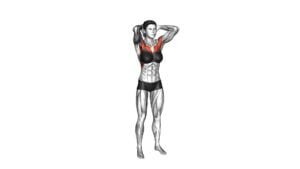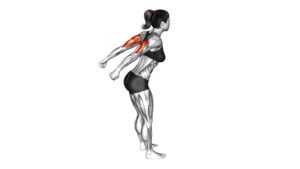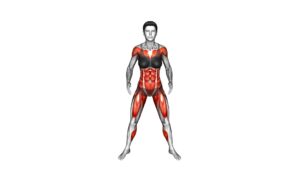Double Pulse Squat Kickback (female) – Video Exercise Guide & Tips

Get ready to tone and strengthen your lower body with the Double Pulse Squat Kickback. This video exercise guide and tips will show you the proper form and technique for this effective workout.
Watch This Exercise Video
Whether you're a beginner or advanced, there are modifications and progressions for all fitness levels. Maximize your results with these helpful tips.
Let's get started and take your squat kickbacks to the next level!
Key Takeaways
- The Double Pulse Squat Kickback combines weightlifting benefits with targeted glute activation.
- Engaging the glutes and lower body muscles improves strength and power.
- The double pulse motion increases the effectiveness of the exercise.
- This exercise helps improve athletic performance and reduces the risk of injuries.
Benefits of the Double Pulse Squat Kickback
Get ready to experience the benefits of the Double Pulse Squat Kickback. This exercise combines weightlifting benefits with targeted glute activation, making it an excellent addition to your workout routine. By incorporating weights into the squat kickback, you not only engage your glutes but also challenge your lower body muscles, promoting strength and power. The double pulse motion adds an extra element of intensity, increasing the effectiveness of the exercise.
When performing the Double Pulse Squat Kickback, the glutes are the primary muscle group targeted. These muscles play a crucial role in stabilizing the hips and lower back, as well as aiding in movements such as walking, running, and jumping. By activating and strengthening the glutes, you can improve your overall athletic performance and reduce the risk of injury.
In addition to glute activation, this exercise also engages the quadriceps, hamstrings, and calves. The squat portion of the movement targets the quads and hamstrings, while the kickback targets the glutes and calves. This comprehensive activation of multiple muscle groups allows for a more efficient and effective workout.
Now that you understand the benefits of the Double Pulse Squat Kickback, let's move on to the equipment needed for this exercise.
Equipment Needed for the Exercise
To perform the Double Pulse Squat Kickback, you'll need a set of dumbbells. This exercise targets multiple muscle groups in the lower body, including the glutes, hamstrings, and quadriceps. The dumbbells provide added resistance to challenge your muscles and increase strength.
When choosing the right weight for squat kickbacks, it's important to consider your fitness level and goals. If you're a beginner, start with lighter weights and gradually increase as you build strength and confidence. On the other hand, if you're more advanced, you may need heavier weights to challenge your muscles effectively.
It's essential to choose a weight that allows you to maintain proper form throughout the exercise. If the weight is too heavy, you may compromise your technique and increase the risk of injury. Alternatively, if the weight is too light, you won't be effectively stimulating your muscles.
Experiment with different weights to find the right balance between challenge and control. Remember to always warm up before starting any exercise and consult with a fitness professional if you have any concerns or specific goals.
Proper Form and Technique for the Double Pulse Squat Kickback
To perform the Double Pulse Squat Kickback with proper form and technique, follow these steps:
- Stand with your feet shoulder-width apart and your hands on your hips.
- Lower yourself into a squat position by bending your knees and pushing your hips back.
- Once in the squat position, pulse twice by quickly lowering your body slightly deeper into the squat and then returning to the starting position.
- After the second pulse, shift your weight onto your left leg and kick your right leg straight back, engaging your glutes and hamstrings.
- Return your right leg to the starting position and repeat the double pulse squat kickback on the other side.
Common mistakes to avoid when performing the Double Pulse Squat Kickback include:
- Allowing your knees to cave inwards during the squat portion of the exercise.
- Rounding your back or hunching your shoulders.
- Not engaging your core muscles.
- Leaning too far forward or backward during the kickback movement.
- Performing the exercise too quickly, sacrificing proper form.
Variations of the Double Pulse Squat Kickback can include adding resistance by holding dumbbells or wearing ankle weights, or performing the exercise on a stability ball to challenge your balance and core stability. Remember to always listen to your body and adjust the intensity and range of motion to your fitness level.
Modifications and Progressions for All Fitness Levels
To modify or progress the Double Pulse Squat Kickback for all fitness levels, you can adjust the intensity, range of motion, or add additional resistance. These modifications not only help prevent injuries but also maximize muscle activation during the exercise.
For beginners or those with limited mobility, it's important to start with a lower intensity. This can be done by reducing the depth of the squat and the range of motion for the kickback. Focus on maintaining proper form and engaging the glutes throughout the movement. As your strength and flexibility improve, gradually increase the intensity by increasing the depth of the squat and the range of motion for the kickback.
To further challenge yourself and progress the exercise, you can add additional resistance. This can be done by holding a dumbbell or a resistance band around your thighs while performing the double pulse squat kickback. The added resistance increases the workload on the muscles, leading to greater muscle activation and strength gains.
Remember to listen to your body and make adjustments accordingly. If you experience any pain or discomfort, modify the exercise to a level that's safe and comfortable for you.
Tips for Maximizing Your Results With the Double Pulse Squat Kickback
Maximize your results with the Double Pulse Squat Kickback by incorporating these tips:
- Maintain proper form: To ensure maximum effectiveness, it's crucial to maintain proper form throughout the exercise. Keep your back straight, engage your core, and avoid rounding your shoulders.
- Engage your glutes: Focus on squeezing your glutes at the top of the kickback movement. This will help to activate and strengthen the glute muscles.
- Control your movements: Avoid using momentum to perform the exercise. Instead, focus on controlled movements to engage the targeted muscles and prevent injury.
- Gradually increase weight: As you become more comfortable with the exercise, gradually increase the weight to challenge your muscles. This will help to promote muscle growth and strength.
- Avoid common mistakes: Be cautious of common mistakes such as arching your back, allowing your knees to cave inwards, or using your lower back to lift the weight. Pay attention to your form and make necessary adjustments to avoid these mistakes.
Variations and alternatives: If you're looking to switch things up or target different muscles, consider trying variations of the Double Pulse Squat Kickback. Some alternatives include the single-leg squat kickback or the standing cable kickback. These variations can provide a different challenge and help to target specific muscle groups. Experiment with different variations to find what works best for you and your fitness goals.
Frequently Asked Questions
How Many Calories Does the Double Pulse Squat Kickback Burn?
The double pulse squat kickback is a great exercise for burning calories and improving overall fitness. By combining a squat with a kickback, you engage multiple muscle groups, including the glutes, quads, and hamstrings. This helps to increase your heart rate and burn more calories during the workout.
For advanced trainees, variations of this exercise can be performed using resistance bands or dumbbells to add extra challenge and intensity. Incorporating this exercise into your routine can help you reach your fitness goals and burn calories effectively.
Can Men Also Perform the Double Pulse Squat Kickback?
Yes, men can also perform the double pulse squat kickback. This exercise isn't limited to just females.
It's a great workout for both men and women to strengthen their glutes and hamstrings. Men can benefit from the double pulse squat kickback by incorporating it into their leg or lower body workouts.
There are variations of this exercise that can be modified to suit different fitness levels and goals.
Is the Double Pulse Squat Kickback Suitable for Beginners?
For beginners, the double pulse squat kickback can be a challenging exercise, but with proper form and modifications, you can do it!
Start by standing with feet hip-width apart, then lower into a squat, keeping your knees aligned with your toes. Engage your glutes and core as you push through your heels to stand up and extend one leg back into a kickback.
Remember to double pulse in the squat position before each kickback. Take it slow and listen to your body to avoid injury.
Can the Double Pulse Squat Kickback Help With Cellulite Reduction?
The double pulse squat kickback is a great exercise for cellulite reduction. By incorporating this move into your workout routine, you can target the glutes and thighs, helping to tone and firm those areas.
This exercise also increases muscle activation and improves overall strength. The double pulse motion adds an extra challenge, making it even more effective for cellulite reduction.
How Often Should the Double Pulse Squat Kickback Be Performed for Optimal Results?
To achieve optimal results with the double pulse squat kickback, it's important to consider the frequency of the exercise. The frequency will depend on your fitness level and goals.
Generally, performing this exercise two to three times a week can be beneficial. However, it's also important to vary the intensity and variations of the double pulse squat kickback to challenge your muscles and prevent plateauing.
Consult with a fitness professional to determine the best frequency and variations for your specific needs.
Conclusion
In conclusion, the double pulse squat kickback is a highly effective exercise for targeting the glutes and legs. By incorporating a double pulse and a kickback motion, this exercise helps to strengthen and tone these muscle groups.
It can be modified and progressed to suit different fitness levels, making it suitable for beginners and advanced individuals alike. By following proper form and technique, and incorporating these tips, you can maximize your results with the double pulse squat kickback.

Author
Years ago, the spark of my life’s passion ignited in my mind the moment I stepped into the local gym for the first time. The inaugural bead of perspiration, the initial endeavor, the very first surge of endorphins, and a sense of pride that washed over me post-workout marked the beginning of my deep-seated interest in strength sports, fitness, and sports nutrition. This very curiosity blossomed rapidly into a profound fascination, propelling me to earn a Master’s degree in Physical Education from the Academy of Physical Education in Krakow, followed by a Sports Manager diploma from the Jagiellonian University. My journey of growth led me to gain more specialized qualifications, such as being a certified personal trainer with a focus on sports dietetics, a lifeguard, and an instructor for wellness and corrective gymnastics. Theoretical knowledge paired seamlessly with practical experience, reinforcing my belief that the transformation of individuals under my guidance was also a reflection of my personal growth. This belief holds true even today. Each day, I strive to push the boundaries and explore new realms. These realms gently elevate me to greater heights. The unique combination of passion for my field and the continuous quest for growth fuels my drive to break new ground.







